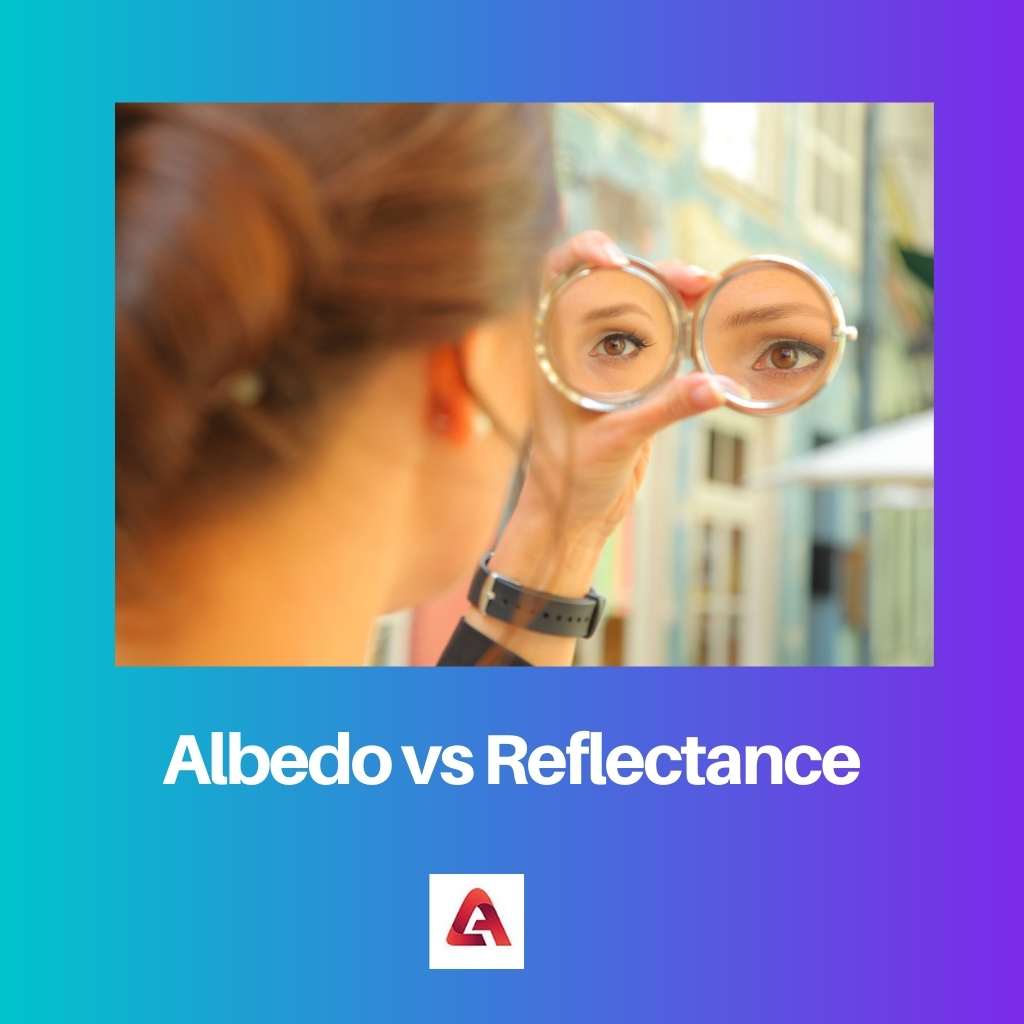Albedo and reflectance are two key terms in electromagnetic wave reflection. These two notions are extremely important in sciences like astronomy, chemistry, geology, and even biology.
The Albedo of a thing is a measurement of how efficiently it reflects light. The ratio of reflected radiant flux to incident radiant flux on a surface is called reflectance.
Key Takeaways
- Albedo measures the fraction of solar radiation reflected by a surface, while reflectance quantifies the proportion of incident light reflected by an object.
- Albedo is a dimensionless value between 0 and 1, with higher values indicating more reflection; reflectance is expressed as a percentage.
- Albedo considers the entire electromagnetic spectrum, but reflectance can be specific to certain wavelengths.
Albedo vs Reflectance
The difference between Albedo and reflectance is that the proportion of solar radiation striking a surface that is reflected away from the earth is called Albedo. The ratio of the quantity of light not absorbed by a character to the amount of light striking it is known as surface reflectance. Surface Reflectance is a material attribute, while Albedo is a energy measurement.

Albedo is a metric for determining how much radiation is reflected from a surface. It compares the quantity of radiation reflected from a character with the amount of radiation that strikes it.
This concept also refers to the amount of energy emitted by electromagnetic waves reflected in the source.
The ratio of the quantity of light leaving a target to the amount of light striking the target is known as reflectance. It doesn’t have any units.
Reflectance is a concept that is more commonly used in science and engineering. The thickness of the substance determines reflectance.
Comparison Table
| Parameters of Comparison | Albedo | Reflectance |
|---|---|---|
| Type of property | Material-specific. | Not a material-specific property. |
| Range of use | Absorption of visible and infrared light. | Radiation emitted. |
| Usage in professional fields | They are used in physics and engineering. | Used in physics and engineering. |
| Dependence | Does not depends on the thickness of the substance. | Depend on the thickness of the substance. |
| Factors that affect | The medium of the incident beam affects it. | The medium of the incident beam does not affect it. |
What is Albedo?
Albedo is the percentage of light reflected by an object or surface. It’s a term used in astronomy to explain how planets, satellites, and asteroids reflect light.
Normal Albedo and Bond albedo are the two forms of Albedo that are used.
The former measures a surface’s relative brightness when lighted and examined vertically, also known as average reflectance.
Observations of normal Albedo are commonly used to estimate the surface compositions of satellites and asteroids. The brightness of such objects is determined by their Albedo, diameter, and distance.
Bond albedo is a measure of a planet’s energy balance, defined as the proportion of total incident solar radiation reflected in space by the globe.
Because Bond albedo is defined throughout the complete range of wavelengths, its value is determined by the spectrum of incident light.
The Bond albedo of the Earth has been measured using Earth-orbiting satellites. In climate research, it is critical to establish how materials impact the climate via the amount of radiation they absorb or reflect.
Albedo is vital in astronomy for identifying faint objects like asteroids, mapping the surfaces of remote solar system objects, and maybe researching exoplanets. Albedo is a decimal scale that ranges from 0 to 1.
A score of 0 indicates that the absorber is ideal and does not reflect any radiation. A substance that reflects all radiation, or a perfect reflector, has a value of 1.
What is Reflectance?
The capacity of a substance to reflect energy striking its surface is known as reflectance. When light and solar radiation are incidents on the surface of a sense, its reflectance is determined.
In terms of surface finish, this value may be used to characterize the nature of a surface. In soil science, reflectance determines the physical parameters of soils, such as particle size and moisture content.
Reflectance spectroscopy is highly essential in astronomy since it is the principal tool for learning about the nature and constitution of celestial objects like planets and asteroids.
The proportion of an electric field reflected at an interface is called the “reflection coefficient.” This “reflection coefficient,” on the other hand, is linked to reflectance.
Fresnel’s equation may be used to calculate this reflection coefficient. It can be either a real or a complex number. The value of the square of the reflection coefficient determines the reflectivity of a surface.
A surface’s reflectivity is always positive. When an object’s reflectance is zero, it would not reflect any of the electromagnetic waves that strike it.
All EM waves are absorbed, and no optical or electromagnetic approach can perceive the thing. If an object’s reflectance is 100 per cent, it does not absorb any electromagnetic waves that strike it.
Such items are ideal reflectors.
Main Differences Between Albedo and Reflectance
- Albedo is a feature of a particular substance, whereas reflectance is not material-specific.
- Albedo is a term that relates to the absorption of visible and infrared light, whereas reflectance is a phrase that refers to all types of radiation emitted.
- Albedo is employed in astronomy and climate research, whereas reflectance is utilized more broadly in physics and engineering.
- The Albedo of a substance does not directly rely on its thickness, although the reflectance of the material does.
- Reflectance is affected by the medium of the incident beam, whereas Albedo is unaffected by the medium of the incident beam.



